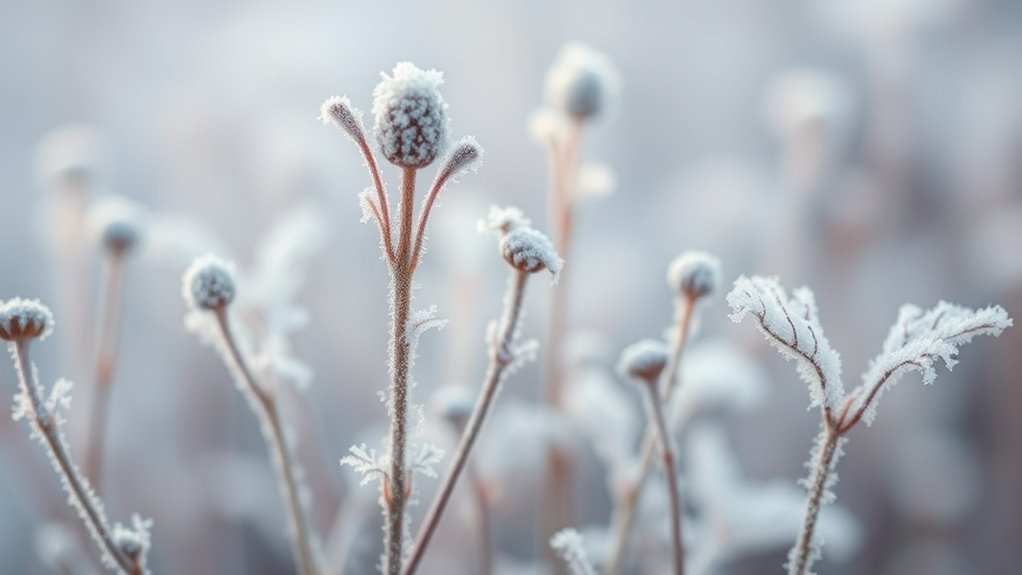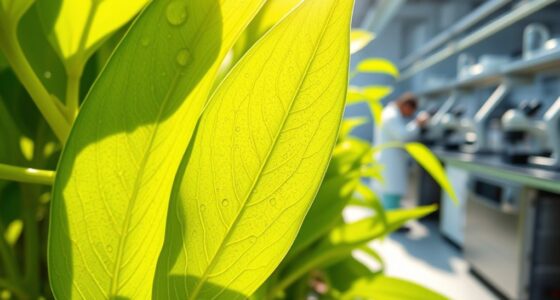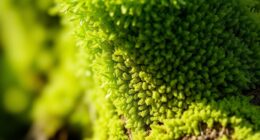Plants survive winter by using special antifreeze proteins and solutes that lower freezing points and prevent ice crystals from damaging cells. They control water movement, promoting dehydration to avoid intracellular freezing and facilitate supercooling, where water stays liquid below freezing temperatures. These adaptations work together to keep cells intact and functional despite extreme cold. To discover more about how these remarkable strategies help plants withstand ice, explore further.
Key Takeaways
- Plants produce antifreeze proteins that inhibit ice crystal growth, preventing cellular damage during freezing temperatures.
- Accumulation of solutes like sugars lowers cellular freezing points and stabilizes membranes in cold conditions.
- Cellular dehydration occurs to reduce water content inside cells, minimizing ice formation and physical damage.
- Supercooling allows plant water to remain liquid below freezing temperatures, avoiding intracellular ice formation.
- A combination of antifreeze compounds and water regulation strategies enhances plants’ frost tolerance and winter survival.

Despite the harsh conditions of freezing temperatures, many plants have developed remarkable adaptations to survive on ice-covered landscapes. One of the most fascinating strategies involves antifreeze mechanisms that prevent their cells from succumbing to the damaging effects of ice formation. When temperatures plummet, water inside plant cells begins to freeze, which can cause the cells to rupture and die. To counter this, these plants produce specialized proteins and solutes that lower the freezing point of their cellular fluids, effectively acting as natural antifreeze agents. These antifreeze mechanisms enable plants to maintain cellular integrity even in extreme cold, allowing them to survive and resume growth when conditions improve.
Many plants survive freezing temperatures with antifreeze proteins and solutes that prevent cell damage.
Another critical adaptation is cellular dehydration. As ice forms outside the cells, the water inside the cells is drawn out to prevent intracellular ice formation, which is highly destructive. This process reduces the overall water content within the cells, making them less susceptible to freezing damage. To manage this controlled dehydration, plants accumulate osmoprotectants—small molecules like sugars and amino acids—that stabilize cell membranes and proteins during water loss. By carefully regulating cellular dehydration, these plants minimize the risk of ice crystal formation inside their cells, ensuring that their essential structures remain intact.
You might notice that these adaptations aren’t just about stopping ice from forming; they’re also about surviving the stress that comes with cold. For example, the production of antifreeze proteins doesn’t just prevent ice crystals—they also help control where and how ice forms, promoting supercooling, where water remains liquid below its normal freezing point without actually turning into ice. This supercooling allows plants to stay in a state of suspended animation until warmer temperatures arrive. Meanwhile, cellular dehydration, although seemingly harsh, actually protects the cell’s internal components by preventing the physical damage caused by ice crystals. The process is finely tuned, with plants balancing water loss and protection to survive prolonged cold periods.
In essence, these mechanisms work together, forming a sophisticated system that enables plants to endure winter’s relentless freeze. Their antifreeze strategies and ability to manage cellular dehydration are key to their frost tolerance. By producing antifreeze compounds and controlling water movement, plants on ice have evolved to thrive in environments where most other organisms would perish. So next time you see a hardy plant thriving amidst snow and ice, remember the incredible biological adaptations working tirelessly beneath the surface—keeping them alive against all odds.
Frequently Asked Questions
How Do Plants Detect Approaching Frosts?
You can see that plants detect approaching frosts through frost sensing mechanisms involving temperature receptors. These receptors monitor changes in temperature, especially sudden drops, triggering responses like producing protective sugars or altering cell structures. When temperatures fall, your plants’ temperature receptors sense the cold, activating signaling pathways that prepare them for frost. This early detection helps plants build tolerance and survive harsh winter conditions.
Can Frost-Tolerant Plants Survive Urban Pollution?
Yes, frost-tolerant plants can survive urban pollution because their urban resilience helps them withstand pollution effects. Their adaptations enable them to handle harsh conditions, including air pollutants, which can stress less resilient plants. You should still monitor pollution levels, as extreme pollutants might weaken even hardy species. Overall, their natural resilience gives them an advantage in urban environments, making them better equipped to survive and thrive despite pollution effects.
What Role Do Plant Hormones Play in Freezing Resistance?
Imagine you’re a medieval alchemist—your hormones are like magical potions. They play a key role in freezing resistance by triggering hormonal signaling that activates stress adaptation responses. When temperatures drop, these signals help plants produce protective compounds, adjust cell membranes, and prevent ice damage. So, your plant’s ability to survive winter hinges on these hormonal cues, orchestrating a crucial defense against the cold’s harsh effects.
Are There Any Edible Frost-Resistant Plants?
Yes, you can enjoy edible frost-resistant plants like winter greens and herbs. Edible winter greens, such as kale and collards, thrive in cold weather and stay flavorful even after frost. Frost-resistant herbs like thyme, rosemary, and chives also survive winter, adding fresh flavor to your dishes. These plants are perfect for extending your growing season, so you can harvest nutritious greens and herbs during colder months without worrying about frost damage.
How Quickly Can a Plant Recover After Frost Damage?
Your plant’s frost recovery can be astonishing, often happening within days or weeks depending on damage severity. You might see new growth in just a week, showcasing remarkable plant resilience. Keep in mind, healthy plants with strong resilience bounce back faster, while severely damaged ones take longer. Proper care, like gentle pruning and adequate watering, boosts frost recovery, helping your plants regain their vitality swiftly and thrive despite winter’s hardships.
Conclusion
As you explore the secrets of frost tolerance, one thing becomes clear: these plants hold mysteries that could transform your understanding of survival. Just when you think you know how they withstand winter’s harsh grip, new questions arise—what hidden tricks are they hiding? The more you discover, the more you realize there’s still so much to uncover. Stay curious, because the coldest secrets are waiting to be revealed—and they might change everything you thought you knew.










